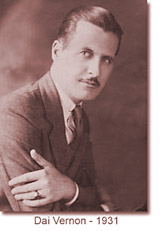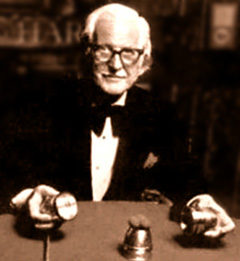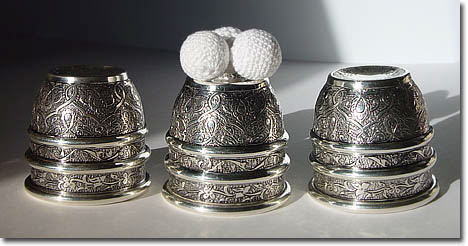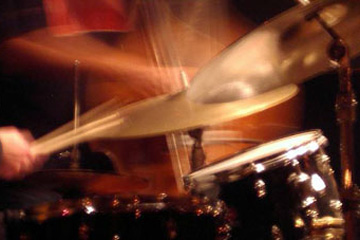Dai Vernon

Dai Vernon was one of the most influential magicians of the 20th century. He transformed the ancient art of magic into a polished, refined craft capable of entertaining and astonishing a contemporary audience.
Dai Vernon was "The Man That Fooled Houdini." Harry Houdini had boasted that he could not be fooled by anyone if he saw a trick performed three times in a row. In Chicago , in 1919, Dai Vernon took Houdini up on the challenge. He performed a trick that is now known as The Ambitious Card. Dai Vernon performed the trick a second and third time, finally after repeating the illusion eight times, Harry Houdini admitted had no idea how the trick was done.
As one of the most proficient sleight of hand artists ever, Dai Vernon captured the imaginations of magicians around the world with his incomparable skill. "If you want to be an artist," he said, "you must devote your life to it. Chess, music, anything. After you get just so high, you realize that if you want to be truly great, you have to give up everything else -- you have to dedicate your life to your art."

It was not his skill alone that enabled Dai Vernon to take a fair trick and turn it into a masterpiece, he would turn the trick inside out and truly make it his own. He said "it's no good to copy, someone who copies doesn't know the reasoning, he doesn't know what's behind the effect. He doesn't know what the feeling should be so he doesn't put any feeling into it. That is what there should be in every work of art . . . feeling."
In the mid-1960s, Dai Vernon left the East Coast for a visit to California. He liked it so much that he stayed. He became a resident magician at the Magic Castle in Hollywood. He sat in the corner, with a Particus Cigar and a shot of something to drink, and thousands of magician's came to visit him, drawn by his kindness and sincerity as well as his artistry. His willingness to share his expertise with others inspired the nickname "The Professor."
One of the oldest tricks in magic is the Cups and Balls. It dates back to ancient Egypt. Three tiny balls disappear and reappear under three ordinary cups. No smoke, no mirrors, no trap doors, no digital effects (computers were a tad scarce back then).
The quality of a Cups and Balls routine relies entirely on sleight of hand skill and misdirection abilities of the magician. Great magicians have been entertaining audiences with simple looking cups and balls routines for literally thousands of years. It really is magic if you think about it. Dai Vernon performed with beautiful engraved silver cups and took the art of the routine to a whole new level.

"The Magician and the Cardsharp" by Karl Johnson is a excellent book about Dai Vernon's long quest to meet, and learn from, a card sharp by the name of Allen Kennedy (1865–1961). Proficient at dealing from the top and bottom of a deck of cards, Dai Vernon was astounded to learn that Kennedy had mastered the holy grail of card tricks - the "center deal," – the ability to deal a specific card from anywhere in the deck, undetected.
"The Magician and the Cardsharp" is an engrossing detective story which follows Dai Vernon’s efforts to locate the man who had perfected his craft. The search took him from one sleazy dive to another: bars, nightclubs, pool halls, and smoke-filled back rooms. In 1932, the trail finally led him to a little white house in Pleasant Hill, Mo., where Allen Kennedy lived. Kennedy taught Dai Vernon exactly how to perform the trick great gamblers had assumed was a fairytale.
"The Magician and the Cardsharp" vividly conveys how obsessed Dai Vernon was with magic and card tricks, and how much time, energy, and practice it takes to become a master of your craft. The following is an excerpt from the book which appeared on the NPR website on August 18, 2006:
"
To Dai Vernon, Amador Villasenor was a lucky draw, like turning up three aces in the last hand on a losing night. To the cops in Wichita, who had searched for him for three long years, Villasenor was a gambler, a cardsharp, a thief, and a killer.
. . . Villasenor swore he had acted in self-defense, and the police and his jailers believed what he had to say . . . a young Mexican in his twenties, a gambler well accustomed to the feel of cards and dice.
To Vernon, Villasenor's predicament was a scrape like a million others, a "gambling mix-up," he called it. Vernon was a magician, an artist. Magic was his obsession. It was what he cared about more than anything else.
Magic would keep Vernon up for days at a time with no thought of food or rest. Magic softened these hard times of the Depression. Magic made his dull days cutting silhouettes in a department store in this wheat-and-oil town passable.
Vernon would smile and follow the devil himself if it meant he could bring back something, a sleight, a ruse, a line of patter, that he could use in his art. Vernon was as different from an old-style illusionist as an Impressionist was from a sign painter. Rather than larger and faster, he preferred to make magic that seemed more casual, and thus more natural. He became magic's Picasso, its Hemingway, its Duke Ellington.
Vernon had little interest in the old stage ruses. He believed that sleight of hand and psychological subtlety far surpassed the hidden mirrors and wires used by conventional illusionists. To him, the proper stage for real magic was not the expanse of the vaudeville boards, but the unadorned human hand, held out just before his spectators' eyes. And the best props were not floating women or disappearing automobiles, but cups and balls, coins and cards.
"Show these fellows a couple of those things you were doing with the cards," the guard told Villasenor when they brought him up from the cell block. Villasenor was younger than Vernon, about twenty-nine. He was an experienced sharp with several sleights in his repertoire, moves to "get the money," as the gamblers said. He began by showing the magicians a slick one he had worked up to beat the game of monte, not the well-known three-card short con of riverboat and fairground fame, but a card game popular among the Mexican workers who had been brought up north to labor in Wichita's slaughterhouses and train yards. Vernon watched intently. He could see that Villasenor was a professional, but he could also tell that the Mexican was no great virtuoso. His card handling was workmanlike, good for fooling these jail guards maybe, or drunken marks at a roadhouse, but he was not a genuine sleight-of-hand artist. After demonstrating his monte move, Villasenor showed off a couple of other sleights -- a slip and a shift. Then, he moved on to his false deals. Vernon saw everything coming.
The deepest secrets in magic, he discovered, were usually found in the skillful, fearless hands of those Vernon called the gamblers . . . the greatest magicians of them all.
"You've been a gambler all your life haven't you?" Vernon asked Villasenor as their visit wound down. After the Mexican had finished showing what he could do, they had started to chat. Sure, Villasenor agreed, he had been gambling pretty much all his life. "Well," Vernon continued, "have you ever witnessed anything unusual…? You've played cards all your life, have you ever seen anything you don't understand?"
Villasenor's English may have been a little shaky, but he didn't hesitate now as he answered the magician. "In Kansas City," he replied immediately, a surge of excitement in his voice, "I see a fella. He deals cards from the center of the pack...."
"Perfect," the gambler answered every time. Perfect. It was a word Vernon always shunned. Yet Villasenor threw it down confidently, as he would a winning hand or a pair of loaded dice. Perfect.

